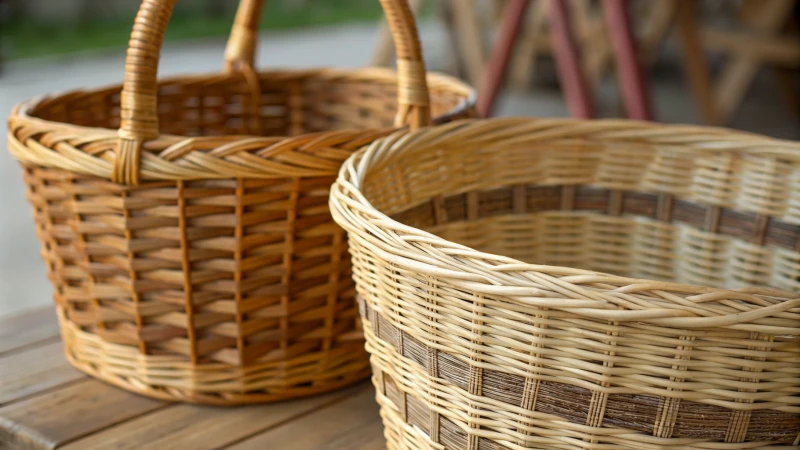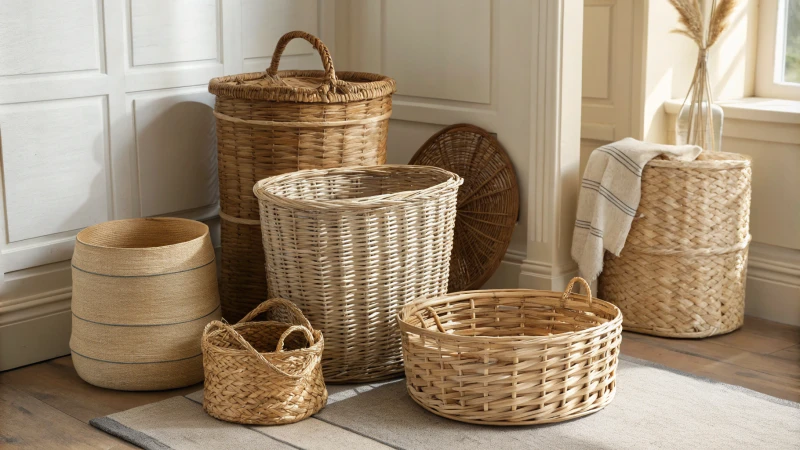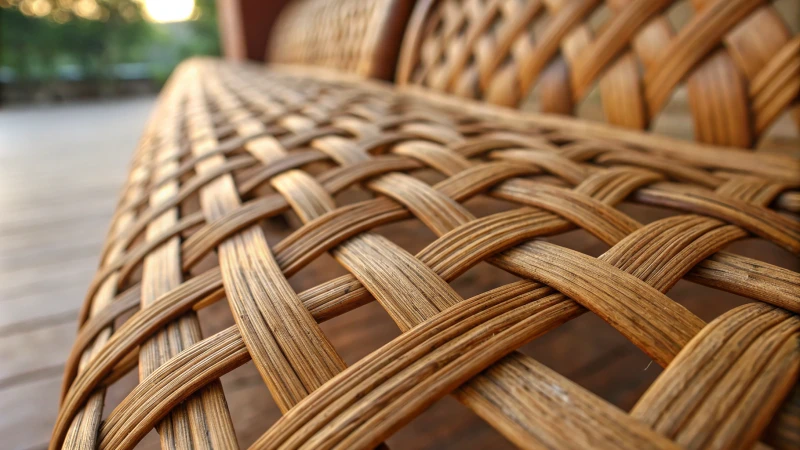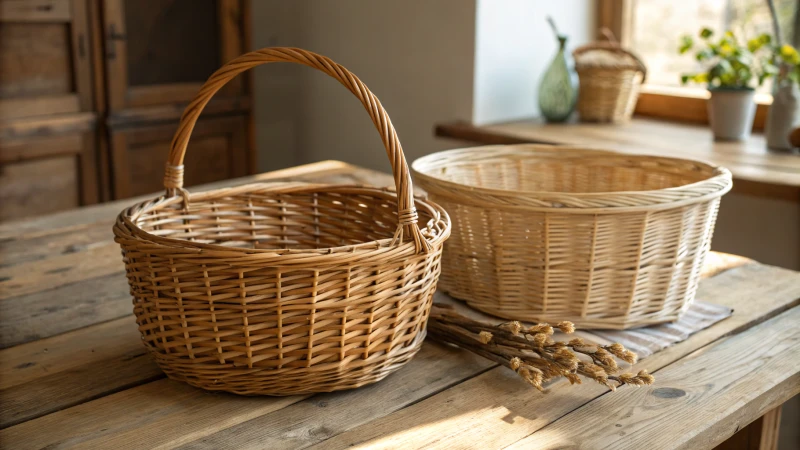
Many people become confused by the words ‘wicker’ and ‘rattan’ when shopping. You are not the only one! Let’s figure this out together!
Wicker is the weaving method used for creating baskets. Rattan is a specific material often used in wickerwork. Understanding these differences helps in choosing home décor. People pick the right products that fit their style. It’s very important.
I have explored home décor for many years. I remember when I first discovered wicker and rattan. I searched for the perfect basket for my living room. It felt like a maze! Wicker is not a material. It refers to a weaving method. Rattan is different. It is a beautiful and strong vine often used in weaving. Knowing this difference enriched my shopping journey. It helped me choose items that matched my style and needs. Believe me, understanding these differences probably really improves your home décor experience!
Wicker is a weaving technique, not a material.True
Wicker describes the method of weaving, while rattan is the material often used in this technique.
All wicker baskets are made from rattan.False
Not all wicker baskets use rattan; they can be made from various materials like willow or bamboo.
What Makes Wicker Baskets So Special?
Do you ever wonder why wicker baskets are a popular choice for home decor? Let’s discover the special traits that make them different. These baskets are unique and well-loved. Many people find them appealing.
Wicker baskets are loved for their natural materials such as rattan, willow and bamboo. These materials offer strength and beautiful looks. Crafted by hand, these designs show cultural traditions. They fit well in decoration and storage. They are ideal for those wanting to mix beauty with usefulness.

Wicker baskets offer more than just storage; they contain history, craftsmanship and warmth for our homes. I remember when I first found a handwoven wicker basket at a market. Its detailed design caught my eye. I imagined the story of its creation – the careful hands and chosen materials. That day, I realized these baskets mix practicality with art effortlessly.
Material Composition
Wicker baskets use natural materials that are truly captivating. They usually come from rattan, willow or bamboo, each offering unique qualities and strength.
- Rattan: Strong yet elegant, rattan endures daily use while staying beautiful.
- Willow: Willow adds a cozy, rustic touch, fitting for a country-style home.
- Bamboo: Lightweight and eco-friendly, bamboo appeals to those who appreciate sustainability and modern style. It’s wonderful for the earth.
For those interested in understanding how these materials compare, consider the following table:
| Material | Durability | Aesthetic | Eco-Friendliness |
|---|---|---|---|
| Rattan | High | Elegant | Yes |
| Willow | Medium | Rustic | Yes |
| Bamboo | Low | Contemporary | Yes |
Craftsmanship and Design
Each wicker basket displays its story through craftsmanship. I admire how artisans weave them with care, mixing utility and beauty. These designs convey cultural traditions, from simple to intricate styles.
-
Weaving Techniques: Basket strength and looks depend on the weaving style. Tight weaves offer durability while loose weaves allow breathability.
-
Customization: Many suppliers provide options for customization. Choosing colors and sizes to fit my design ideas gives a personal touch that I truly enjoy.
Versatility in Functionality
Wicker baskets excel in versatility. They shift easily from practical storage to beautiful décor in any space.
-
Home Décor: They add texture and warmth. Whether for a bohemian corner or a rustic entryway, they complete the look perfectly. Explore design ideas1.
-
Storage Solutions: They organize with style! Their lightweight nature allows easy movement, which is really helpful for my changing home style.
Maintenance and Care
Taking care of wicker baskets keeps them at their best.
- Cleaning: Regular dusting and a damp cloth wipe prevent dust buildup. Mild soap with water offers a deeper clean.
- Storage: I store baskets in a dry place away from sunlight to avoid fading and keep their freshness.
Knowing these details helps people make thoughtful choices when buying wicker baskets. They bring beauty, joy and usefulness into our lives.
Wicker baskets are primarily made from synthetic materials.False
This claim is false; wicker baskets are traditionally made from natural materials like rattan, willow, and bamboo.
Wicker baskets can serve both decorative and storage purposes.True
This claim is true; wicker baskets are versatile and suitable for home décor as well as organizing items.
What Makes Rattan Stand Out Among Other Woven Materials?
I have explored the complex world of home décor. I now truly appreciate rattan. Rattan stands out because of its unique qualities. People shopping for woven materials should understand rattan. It might change how you see your home space. Maybe even your perspective.
Rattan stands out from materials like bamboo and wicker. Its unique flexibility makes it special. This vine-based material is durable and inviting. It offers a really warm, natural look. This material is remarkably resilient. It is perfect for both indoor and outdoor spaces.

Rattan in Home Design
Rattan is not just any woven material. It is a lively part of home design that really speaks to me. I recall the first time I saw a beautifully crafted rattan chair. It was not merely a piece of furniture; it was a statement. Rattan is different from bamboo or wicker. It combines flexibility and durability, allowing for detailed designs.
Rattan lasts for a long time, and its warm, natural look adds a cozy feel to any room. This is why I often select rattan pieces for my own home.
Unique Characteristics of Rattan
Rattan is often compared to other woven materials like bamboo, cane, and wicker. Its unique features set it apart. For instance, rattan is a vine that grows in tropical climates, while bamboo is a grass. This fundamental difference influences their texture, flexibility, and durability.
Rattan offers a warm, natural aesthetic that makes it popular in home décor. It is more flexible than bamboo, allowing for intricate designs in furniture. Its sturdy nature means it can withstand wear and tear, making it a favorite choice for outdoor furniture as well.
For a deeper comparison of these materials, check out this guide on woven material options2.
Durability and Maintenance
When considering durability, rattan stands out for its resistance to moisture and humidity, which makes it less prone to warping compared to other materials like wicker or cane. However, rattan needs proper maintenance such as regular cleaning and occasional treatments to preserve its finish and prevent mold growth.
In contrast, synthetic alternatives like resin wicker are even more durable but may lack the natural charm of rattan. Below is a quick comparison table:
| Material | Durability | Maintenance | Aesthetic |
|---|---|---|---|
| Rattan | High | Moderate (requires care) | Natural look |
| Bamboo | Moderate | Low (easy care) | Natural look |
| Cane | Moderate | High (needs special care) | Vintage feel |
| Synthetic Wicker | Very High | Low (easy care) | Varied styles |
For more insights on maintenance practices for rattan, explore rattan care tips.
Cost Considerations
Cost is always a factor when choosing materials. Rattan tends to be more expensive than synthetic options due to its natural sourcing and the craftsmanship involved in weaving. However, many buyers find that the investment pays off in terms of longevity and aesthetic value.
Comparatively, bamboo is often cheaper but may not offer the same durability as rattan. Exploring the price differences can help you make an informed decision. Check out cost comparisons for various woven materials to see which fits your budget.
Applications and Design Versatility
Rattan’s versatility allows it to be used in various applications ranging from furniture to decorative items. It can be styled to fit modern, rustic, or bohemian décor. Wicker, often confused with rattan, typically refers to the weaving technique used with different materials.
When designing spaces, the choice between rattan and other materials can significantly impact the overall feel. Whether you’re looking for dining chairs or accent pieces understanding these differences will aid your selection process. For design inspirations using rattan visit design ideas.
Rattan is more flexible than bamboo for intricate designs.True
Rattan's flexibility allows for complex furniture designs, unlike bamboo which is less adaptable.
Synthetic wicker is more durable than rattan.True
Synthetic wicker offers superior durability compared to rattan, especially against moisture and wear.
What Should You Consider When Choosing Between Wicker and Rattan?
Deciding between wicker and rattan might seem confusing, right? Both have special traits and many uses. Knowing what to think about is important. Let’s explore the basics. This probably helps you choose wisely.
When you choose between wicker and rattan, think about durability, maintenance, looks and cost. Rattan usually offers more durability and a natural appearance. Wicker’s strength depends on its base material.

Understanding the Materials: Wicker vs. Rattan
When exploring furniture for my outdoor area, I found many material choices. Two options that stood out were wicker and rattan. It’s crucial to know how they differ before buying.
Rattan is a strong, climbing palm tree from tropical places. The first time I touched rattan, it felt very strong but also bendable. Rattan easily withstands the outdoors, making it an excellent choice for garden furniture. This material can be woven into many beautiful patterns, allowing for great creativity in decoration.
Conversely, wicker refers to the weaving style that creates pretty items from rattan, bamboo or even synthetic fibers. Wicker enhances spaces aesthetically; however, its strength depends on the materials used in weaving.
Durability and Maintenance
A key lesson from my furniture search was the importance of durability. Rattan pieces last a long time with proper care.
| Material | Durability | Maintenance |
|---|---|---|
| Rattan | High | Requires occasional cleaning with mild soap and water. |
| Wicker | Varies | Dependent on the base material; natural wicker may require more upkeep. |
For my outdoor space, I chose rattan because it survives weather changes better than regular wicker, which often made me worry about damage.
Aesthetic Appeal
Choosing between appearance and suitability can be tough.
- Rattan has a natural beauty with its special texture that appeals to people who care about the environment. I love how versatile it is; rattan smoothly suits various styles, whether I want a bohemian look or modern elegance.
- Wicker, although warm and friendly, might feel less polished if the weave is not great. Both materials can be painted or stained to match any style, but the natural rattan finish aligns well with eco-friendly designs.
Cost-Effectiveness
Now, let’s discuss budget; it’s probably one of the most important decision factors. Rattan often costs more because of its good quality and durability. From my experience, this investment is wise.
Here’s a brief cost comparison:
| Material | Average Price Range (AUD) | Longevity (Years) |
|---|---|---|
| Rattan | $300 – $800 | 10-15 |
| Wicker | $150 – $600 | 5-10 |
Quality rattan fits my sustainability values and proves valuable over time with its durability.
Conclusion: Weighing Your Options
Choosing between wicker and rattan depends on your needs, design goals and budget. Consider how each material matches your space ideas. To learn even more, you could check resources on wicker vs rattan differences3 or how to maintain rattan furniture4. Knowing what each offers will help you decide what feels best for you.
Rattan furniture is generally more durable than wicker.True
Rattan's strength and durability make it ideal for outdoor furniture, outperforming wicker in longevity.
Wicker refers to a type of material used in weaving furniture.False
Wicker is not a material but the weaving technique, often applied to rattan and other fibers.
What Makes Wicker and Rattan Baskets So Different in Price?
Have you ever wondered why some baskets are really expensive while others are cheap? Let’s explore the details of wicker and rattan baskets. This exploration shows what truly drives their price tags. The price differences probably surprise you!
Price differences between wicker and rattan baskets come from material quality, craftsmanship, size, design complexity and market demand. Rattan baskets are usually more expensive. They are very durable and have a handcrafted appeal.

Understanding Wicker and Rattan Baskets
When comparing prices, it’s crucial to first understand the differences between wicker and rattan materials. Wicker is not a material itself; rather, it refers to the technique of weaving materials such as rattan, reed, or willow into various products, including baskets. Rattan, on the other hand, is a specific type of vine that is used to create these woven products. This distinction plays a significant role in the pricing of baskets.
Factors Influencing Price Differences
Several factors can affect the price of wicker and rattan baskets:
- Material Quality: Higher quality rattan often commands a higher price due to its durability and aesthetic appeal. I recall buying a cheap wicker basket that fell apart after a few months; it was very frustrating.
- Craftsmanship: Handcrafted baskets usually come at a premium price compared to mass-produced items. For example, artisans who create intricate designs can charge more for their craftsmanship because each piece is unique and shows a lot of work.
- Size and Design: Larger baskets or those with elaborate designs will typically cost more than smaller, simpler ones. It’s like choosing between a simple or ornate picture frame; details are very important.
- Market Demand: Seasonal trends can influence prices, especially for decorative baskets. During holidays, some decorative baskets became very expensive!
| Factor | Wicker Baskets | Rattan Baskets |
|---|---|---|
| Material Quality | Varies (often less durable) | Generally high quality |
| Craftsmanship | Often machine-made | Usually handcrafted |
| Size | Available in various sizes | Available in various sizes |
| Design Complexity | Simple designs often cheaper | Complex designs cost more |
| Price Range | Lower to mid-range | Mid-range to higher-end |
Pricing Examples
To give you an idea of the price range, here are some common prices found in the market:
- Wicker Basket: Simple medium-sized wicker baskets can range from $15 to $30 depending on the quality and design.
- Rattan Basket: A handcrafted rattan basket with intricate design could range from $30 to $100 or more, reflecting its quality and craftsmanship.
These examples illustrate how the type of material and craftsmanship directly affect pricing. For more detailed comparisons, you might explore wicker versus rattan characteristics5 or how craftsmanship impacts cost6.
Conclusion on Price Differences
While we won’t draw a conclusion here, it’s clear that understanding the nuances of each type of basket can help in making an informed purchasing decision. Those considering eco-friendly options might prefer rattan for its sustainability aspects, while budget-conscious consumers might lean towards wicker alternatives. Further reading on eco-friendly materials7 might also help readers understand the implications of their choices.
Rattan baskets are generally more expensive than wicker baskets.True
Due to higher quality materials and craftsmanship, rattan baskets often cost more compared to wicker alternatives.
Wicker refers to a specific type of material used in baskets.False
Wicker is a weaving technique, not a material, used for creating various woven products including baskets.
Conclusion
Explore the key differences between wicker and rattan baskets, including materials, craftsmanship, durability, and price factors to help you make informed home décor choices.
-
This link provides expert insights on wicker basket characteristics, enhancing your understanding and helping you make informed purchasing decisions. ↩
-
This link provides essential insights into various woven materials, helping you compare their features effectively. ↩
-
Explore this link for expert insights on choosing between wicker and rattan materials for your furniture needs. ↩
-
Learn effective maintenance tips for extending the life of your rattan furniture through this helpful resource. ↩
-
Exploring this link will provide a comprehensive understanding of how craftsmanship affects the pricing of wicker and rattan products. ↩
-
This resource will help you understand the differences between wicker and rattan materials, which is essential for comparing their prices effectively. ↩
-
Reading about eco-friendly materials will enhance your knowledge on sustainable options, aiding in your basket selection process. ↩

